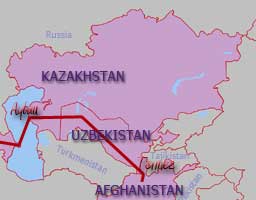Thursday 18 October 2012
Uzbekistan, U.S. Discuss Transit of Cargoes en Route to Afghanistan
Keywords:
(CA-NEWS) – A U.S. delegation led by Gen. William Fraser III, the Commander of the U.S. Transportation Command, visited the Foreign Ministry of Uzbekistan to discuss relevant issues of bilateral cooperation, progress of implementation of earlier reached agreements.

- The southern spur of the Northern Distribution Network, from Poti, Georgia, to Afghanistan
NDN South transits the Caucasus and completely bypasses Russia. This route originates in the Georgian port of Poti on the Black Sea and crosses Azerbaijan before arriving in Baku. From there, goods are loaded onto ferries for their journey across the Caspian Sea. These supplies make landfall at Kazakhstan’s west coast port of Aqtau and then proceed to Uzbekistan before entering Afghanistan. If and when the United States secures a transit agreement from Turkmenistan, the port of Turkmenbashi could be an additional destination for goods leaving Baku by ferry.
The visit started on October 17 and aims to discuss the issues relating to the Northern Distribution Network through which cargo transits Uzbekistan en route to Afghanistan with senior officials of Uzbekistan.
To address ongoing concerns with Pakistani supply lines, U.S. planners have opened the Northern Distribution Network (NDN), a series of commercially-based logistical arrangements connecting Baltic and Caspian ports with Afghanistan via Russia, Central Asia, and the Caucasus. In addition to NDN, Iran and China are also considered possible transit states.
There are several different routes included in the Northern Distribution Network. The most commonly used route, though also one of the longest, starts at the port of Riga, Latvia on the Baltic Sea, and continues for 5,169 km by train southwards through Russia, using railroads built by Russia in the 1980s for the Soviet war in Afghanistan. The supplies then pass through Kazakhstan and Uzbekistan before reaching Afghanistan’s northern border at Termez. To get to the south of the country, the supplies must be loaded onto trucks and transported through the mountainous Hindu Kush by means of the Salang Tunnel. The Salang Tunnel, which is the main connection between northern and southern Afghanistan, is 2.4 km long and situated at an altitude of 3,400 meters. It is prone to avalanches and quite dangerous.
Another, more southern route starts at Poti, Georgia on the Black Sea and continues to Baku, Azerbaijan where the goods are transferred to barges and ferried across the Caspian Sea. Supplies land in Turkmenistan and then move by rail through Uzbekistan before arriving at the Afghan border. In 2010, this route carried one third of the NDN’s traffic.
A third route, created in order to avoid going through the often volatile country of Uzbekistan, goes from Kazakhstan to Kyrgyzstan and then through Tajikistan before reaching Termez.

